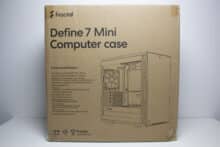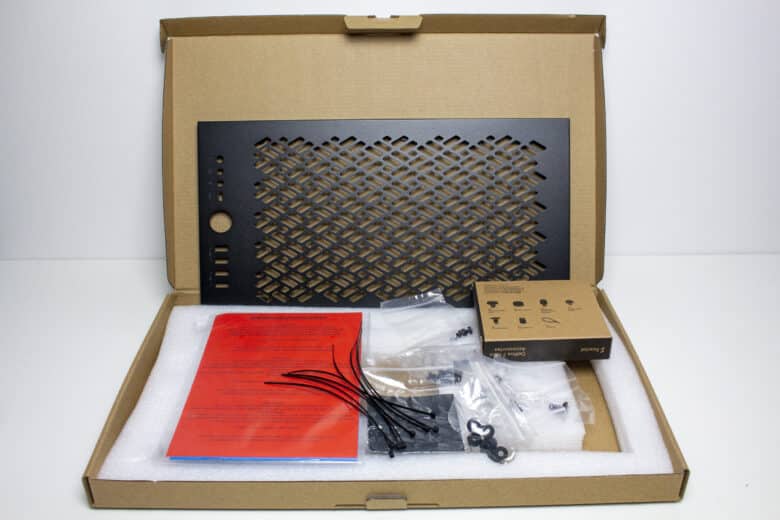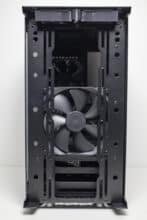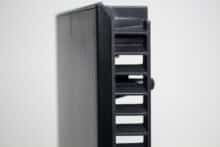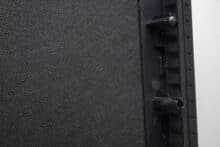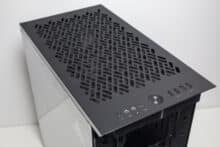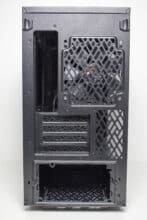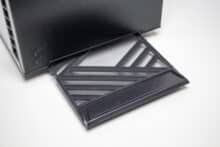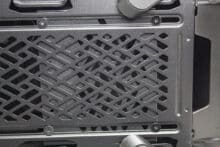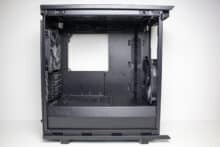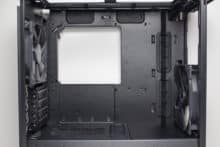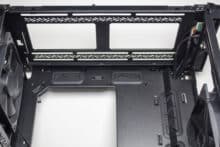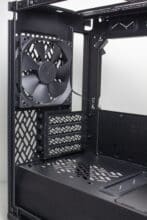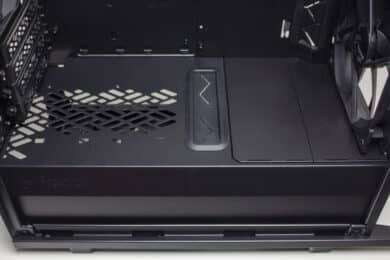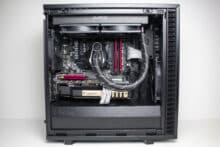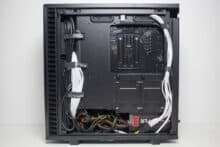
It is hard to imagine the case market without the manufacturer Fractal Design. With the focus on simple and timeless cases, whose main feature is noise reduction, Fractal Design has been able to celebrate many successes with the Define series. This is also reflected in the fact that the series is already in its seventh generation. However, the µATX segment has always been somewhat neglected in recent years. The manufacturer took this as an opportunity in the summer of 2022 to shrink the Define 7 to the Fractal Design Define 7 Mini, which we have for you today in the test.
The Define 7 Mini from Fractal Design basically has a lot in common with its big brother. The Define 7 Mini is available with or without a side window, it offers numerous insulated components, a simple timeless front and plenty of space for hardware. Price-wise, the Define 7 Mini starts at € 88.65 *. As always, our review gets started with the technical details.
Technical details
| Model: | Fractal Design Define 7 Mini |
| Case Type: | µATX/ Mini Tower |
| Dimensions: | 204 mm (W) x 406 mm (H) x 399 mm (D) |
| Weight: | 6.84 kg |
| Material: | Steel, plastic, tempered glass |
| Color: | Black |
| Front connectors | 1x USB 3.1 Type-C, 2x USB 3.0 Type-A, 2x USB 2.0 Type-A, 1x headphone, 1x microphone |
| Drive bays: | 2x 3.5″/ 2.5″ 2x 2,5″ 2x 2.5″ (optional) |
| Expansion slots: | 4x horizontal |
| Form Factors: | ATX, mATX, ITX |
| Ventilation: | Front: 3x 120/ 2x 140 mm Rear: 1x 120 mm Lid: 2x 120 / 2x 140 mm Bottom: 1x 120 mm |
| Radiators: | Front: 1x 240/ 280 mm Rear: 1x 120 mm Lid: 1x 240 mm |
| Max. CPU cooler height: | 167 mm |
| Max. Graphics card length: | 331 mm (with front fan), 306 mm (without front fan) |
| Max. Mains length: | 200 mm (without HDD cage), 165 mm (with HDD cage) |
| Cable management space: | 15 – 25 mm |
| Price: | € 88.65 * |
| Features: | dust filter, cable management, 2 (1x 140 mm, 1x 120 mm) pre-installed fans, tempered glass, sound insulation, exchangeable lid cover |
Fractal Design Define 7 Mini review: the scope of delivery
Fractal Design packages the Define 7 Mini in a box made of plain brown cardboard. In addition, technical drawings, elementary features and all technical data have been printed on the outer cover of the box using black ink. Inside the packaging, the manufacturer uses two blocks of conventional Styrofoam and a protective film to protect the Mini Tower from damage during transport.
Fractal Design stows the mounting accessories in a large box placed in the carton on the side of the case. This contains another box with all the necessary screws as well as some cable ties, detailed assembly instructions as well as warranty information and a steel replacement cover for the lid of the Mini-Tower. In addition, the included accessories include four pre-installed dust filters, a cleaning cloth made of microfiber, and two pre-installed case fans.
Exterior Impression
Basically, the Define series is known for a very simple design. This is no different with the Define 7 Mini. The front panel is completely closed in the front area and consists of a brushed aluminum plate, which was glued to a frame made of plastic and on the inside of which there is also an insulation mat. Fractal Design has completely dispensed with a door in the Define 7 Mini. Instead, there are ventilation openings on both sides including modular dust filters. Besides the Fractal Design logo, there is also a recessed grip in the lower area, which can be used to remove the front panel. Behind it, there are mounting rails for three 120 mm or two 140 mm case fans. Fractal Design has already pre-installed a 140 mm fan here.
The lid of the Mini-Tower is completely closed at the factory and consists of an insulated steel plate under which a removable dust filter has been placed. This doesn’t make sense at first glance, but it is explained when the steel plate is removed and the lid with slotted vents is mounted instead. The mounting is done without tools via steel push pins and works very well. Below the dust filter we also find an air outlet for two 120 or 140 mm fans, the frame of which can also be removed if needed.
The I/O panel is firmly attached to the body, is located in the front area and has two USB 3.0 or two USB 2.0 Type-A ports, one USB 3.1 Type-C port, two jacks for headphones and microphone, respectively, and two buttons for power and reset. There is also a white power LED below the power button.
On our variant, the left side panel is made of tempered glass, which was only lightly tinted and glued to a thin steel frame at the factory. The right side panel was made of steel and glued inside with an insulating mat, which gives the steel additional stability. Both side panels are attached to the body via steel push pins that snap into corresponding receptacles on the body. The side panels could be easily pulled off via a handle on the back. There are also holes behind the front panel for optional screw attachment.
At the back, a typical appearance for a current mini-tower can be seen. The PSU is placed at the bottom and slides into the body from behind over a modular steel frame. Above it, we find four ventilated PCI slot bezels and another ventilation opening to the right of the bezels. In the upper area of the back, we can also discover the second case fan with a frame width of 120 millimeters.
The bottom of the Define 7 Mini is dominated by a huge dust filter made of my mesh fabric, which can be easily removed to the front for cleaning. It is meant to filter the air for the PSU as well as an optional 120mm fan in the bottom, which you can mount when the modular HDD cage is removed.
Interior impression
Fractal Design divides the Define Mini 7’s interior into a large main chamber and a much smaller power supply chamber. The main chamber has room for a µATX motherboard, which can be neatly wired through the four rubberized cable management holes. It also features the obligatory cutout for CPU coolers with backplates. Since Fractal Design does not use HDD cages in the main chamber, the pre-installed front fan can move air into the interior unhindered. Another practical feature is that the mounting frame in the lid can be completely removed with the help of two small screws. This could come in handy especially when installing a radiator.
The power supply chamber at the bottom is separated from the main chamber by a steel panel. Besides a stamped manufacturer logo, the bezel has two more cable management openings, one of them with a rubber sleeve, and more ventilation openings. The latter allow the power supply to be oriented with the fan facing upwards. The front area of the panel is not made of steel, but has two modular plastic plates that can be removed. This is necessary, for example, if a water cooling system is to be mounted in the front.
In the PSU tunnel we find a modular HDD cage made of steel as well as the mounting place for the PSU. For decoupling, Fractal Design provides the mini-tower with four rubber decouplers on which the PSU can rest. The PSU is mounted from the back via a removable steel frame.
On the back of the mainboard tray, the manufacturer completely omits eyelets for cable ties. Instead, six Velcro cable ties are used. These are reusable and thus protect the environment and your nerves, should you ever forget a cable harness. On the left side we also find a recess, which is supposed to serve as a cable channel for the 24-pin ATX and I/O panel cables.
From the factory, the Define 7 Mini can mount up to four data carriers. This includes two 2.5″ SSDs, which can be mounted behind the mainboard tray on corresponding steel plates. Screws or tools have to be used for the installation. If that’s not enough, you have the option of positioning two 3.5″ or 2.5″ HDDs in the lower HDD cage. Again, tools and screws are needed to attach the data carriers to the steel frame. For this, 3.5″ HDDs are decoupled via rubber rings. Optionally, the upper side of the PSU bezel offers two additional mounting points for 2.5″ SSDs. However, corresponding frames have to be purchased additionally and are not part of the scope of delivery.
Fractal Design Define 7 Mini review: workmanship
The build quality is on a very high level and meets the standards we are used to from Fractal Design. The paint job is free of flaws and is evenly done in all places. In addition, there are no sharp edges on the outside or inside that you could injure yourself on. The implementation of the push-pin mechanisms for the side panels as well as the top cover make a durable impression, function smoothly and appear stable. The workmanship and look are rounded off by the brushed aluminum plate of the front panel. This gives the mini tower a simple elegance.
Fractal Design Define 7 Mini review: Installation of the components
Now we come to the system installation in the Define 7 Mini review. For hardware, we are using an AMD Ryzen 5 5600X on an ASRock B450M Pro4 with 16GB of DDR4 3000 MHz. The Ryzen is cooled by an Arctic Liquid Freezer II 240* and is run at its default clock. A Palit GeForce GTX 970 JetStream is responsible for the image output. The FSP Hyper takes care of the power supply with 500W.
The installation as well as the cabling of the hardware were basically done quickly, but also presented us with somewhat bigger challenges in parts. We liked the pre-installed spacers and the generously cut interior. The installation of the water cooling caused us some problems, since the radiator of the Arctic Liquid Freezer II is particularly deep with 38 millimeters. In the lid, it was very tight with the higher heatspreaders of the RAM and in the front, the USB as well as the 24-pin ATX cable were almost in the way. Furthermore, there is actually only room for thicker cables in the cable channel at the back. However, with ambition and a bit more concentration or time, both scenarios could be successfully implemented and wired. Less deep radiators or a CPU air cooler should also keep the effort down.
Despite the right compact dimensions, the Define 7 Mini can swallow quite a bit of hardware. Thus, the CPU cooler may be up to 167 millimeters high and the graphics card up to 331 millimeters long. However, the latter only applies when no fan or radiator is installed in the front. This offers space for a 240 or 280 mm heat exchanger. Alternatively, another 240 mm heat exchanger can be installed in the lid. A power supply should not exceed a length of 165 millimeters in the Define 7 Mini if the HDD cage has to remain installed. Otherwise, it can be 200 millimeters long.
The Fractal Design Define Mini 7 comes with two pre-installed Fractal Design Dynamic X2 case fans ex-works. One with a 140 millimeter frame width (Dynamic X2 GP-14) is used at the front and the version with a 120 millimeter frame width (Dynamic X2 GP-12) at the rear. Both fans are completely black and rotate with a maximum of 1000 (Dynamic X2 GP-14) or 1200 (Dynamic X2 GP-12) revolutions per minute. The connection is made via a conventional 3-pin cable. The use of the PWM variant would have been desirable for the price of the case.
Lastly, we come to the temperatures reached in the Fractal Design Define 7 Mini. During the stress test, Prime95 and FurMark were run at a room temperature of 20 °C for 15 minutes. The table below shows the values on an open-air benchtable as well as the temperatures at 7V and 12V of the case fans. Since an AiO water cooling system is used, it is run with the lid closed at the front and with the lid open at the top.
Scenario |
Temperature |
| CPU: 50% PWM (975rpm) GPU: 50% PWM (1250 rpm) Open-air benchtable (no additional fans) |
CPU: 57.6 °C GPU: 80 °C (temperature limit, clock was reduced to 1354 MHz) |
| CPU: 50% PWM (975 rpm) GPU: 50% PWM (1250 rpm) 1x 120 mm rear fan 7V (750 rpm) Lid closed, radiator in front |
CPU: 63.1 °C GPU: 80 °C (temperature limit, clock was reduced to 1354 MHz) |
| CPU: 50% PWM (950 rpm) GPU: 50% PWM (1650 rpm) 1x 120 mm rear fan 12V (1300 rpm) Lid closed, radiator in front |
CPU: 59.7 °C GPU: 80 °C (temperature limit, clock was reduced to 1354 MHz) |
| CPU: 50% PWM (950 rpm) GPU: 50% PWM (1650 rpm) 1x 140 mm front fan 7V (580 rpm) 1x 120 mm rear fan 7V (750 rpm) Lid open, radiator on top |
CPU: 64.3 °C GPU: 80 °C (temperature limit, clock was reduced to 1354 MHz) |
| CPU: 50% PWM (950 rpm) GPU: 50% PWM (1650 rpm) 1x 140 mm front fan 12V (950 rpm) 1x 120 mm rear fan 12V (1300 rpm) Lid open, radiator on top |
CPU: 63.1 °C GPU: 80 °C (temperature limit, clock was reduced to 1354 MHz) |
Compared to an open test setup, the CPU only reaches slightly higher temperatures in our worst-case scenario. Even with the lid closed, the Ryzen 5 5600X can be easily cooled with the AiO water cooling and there is enough leeway via overclocking or even stronger CPUs in general. Basically, we would therefore not suspect any overheating issues with the graphics card either. However, we noticed that the graphics card of the test system is very close to the Nvidia temperature limit (80 °C) and throttles even in an open configuration. However, since the graphics card got just as warm when installed, but did not throttle further, we assume that the cooling works here as well. Other tests of the Define 7 Mini confirm this assumption.
What can lead to problems, however, are graphics cards with three full slots in connection with a motherboard where the PCIe x16 slot is not located at the very top. These cards would sit directly on top of the PSU cover and most likely not be able to draw in enough air.
Fractal Design Define 7 Mini review: conclusion
Fractal Design has created a very good mini tower with the Define 7 Mini, which knows how to convince with many features. First of all, there is the simple and timeless look as well as the, for a mini tower, very good space conditions and the high hardware compatibility. In addition, there are the excellent features such as the two top covers, two good case fans, full dust filters that can be easily removed or cleaned and the state-of-the-art I/O panel with a total of five USB ports including USB-C. The buyer can also choose whether he wants to present his system or not, thanks to versions with and without a side window.
However, there are still a few negative aspects. Compared to almost all other components and case elements, the installation of the data carriers is not tool-free. Furthermore, the space behind the mainboard tray is only sufficient in the area of the cable channel, and with the HDD cage installed, it’s hard to find room for the cables with a non-modular power supply. Lastly, there could be compatibility problems with protruding graphics cards, as they are then either too long or so deep that the fans lie on the PSU cover. A fifth slot (like in the Define Mini C) would have been an advantage here.
With a price of € 88.65 *, the Fractal Design Define 7 Mini is not exactly one of the cheapest cases. But in return you get a mini tower with a lot of space, excellent features and a modular design, which leaves the decision between “silent” and “airflow” to the buyer. We give it a clear buy recommendation.
Fractal Design Define 7 Mini
Workmanship
Structure
Features
Cooling
Value for money
91/100
The Fractal Design Define 7 Mini is a very good mini tower that convinces with excellent workmanship and features as well as a simple look with plenty of space. Only particularly deep radiators or a lot of cables could be a bit tricky to install.




